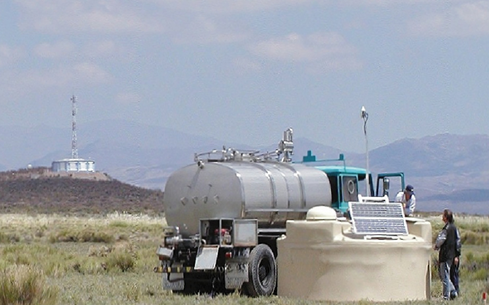Pierre Auger observatory
The Pierre Auger Observatory is currently the largest cosmic-ray detector in the world. Its goal is to study cosmic rays at ultra-high energies (E > 1018 eV). The observatory consists of a set of detectors covering an area of 3000 km² installed in the Argentinian pampas (province of Mendoza).
 One of the 1600 water detectors (foreground) and one of the four fluorescence stations (background) of the Pierre Auger observatory – Credits: Pierre Auger Observatory
One of the 1600 water detectors (foreground) and one of the four fluorescence stations (background) of the Pierre Auger observatory – Credits: Pierre Auger Observatory
The IJCLab group is involved at different levels in the analysis of the Observatory’s data:
- From the detection of showers to the spectrum of cosmic rays;
To construct the cosmic-ray spectrum, different steps are necessary: control and selection of signals from the 1600 water detectors, reconstruction of cosmic-ray energy, evaluation of the exposure of the array as a function of time. - Analysis of cosmic-ray anisotropies;
The study of anisotropies in the arrival directions of cosmic rays is one of the essential tools for tracing their origins. At the most extreme energies, we hope to identify extended excesses of events around putative sources, while around 1018-1019 eV, the very large number of observed events makes it possible to search in the arrival directions for large-scale structures that could mark a transition between galactic and extragalactic cosmic rays. As part of the MICRO ANR project, the group aims at the joint modelling of observables such as the spectrum, the average composition (heavy or light nuclei) and the arrival directions to constrain the highest-energy sources in the Universe. - Nature of cosmic rays at the highest energies;
Knowledge of the nature of cosmic rays is one of the key data to go back to their origin. In particular, at higher energies, lighter cosmic rays are expected to be little deflected by magnetic fields and to point towards the sources that emit them. For this, we need observables sensitive to the nature of the primary and in particular to measure the muon content of the showers detected with the surface detector. - Electronics of the surface detector and the upgrade of the Observatory;
The Auger collaboration plans to continue operating the Observatory by improving its performance, particularly in its ability to discriminate between the nature of primary cosmic rays. IJCLab, already responsible for the electronics of the surface detector tanks since it joined the collaboration in 2000, is leading the upgrade of the electronics that equip the new surface detectors.









